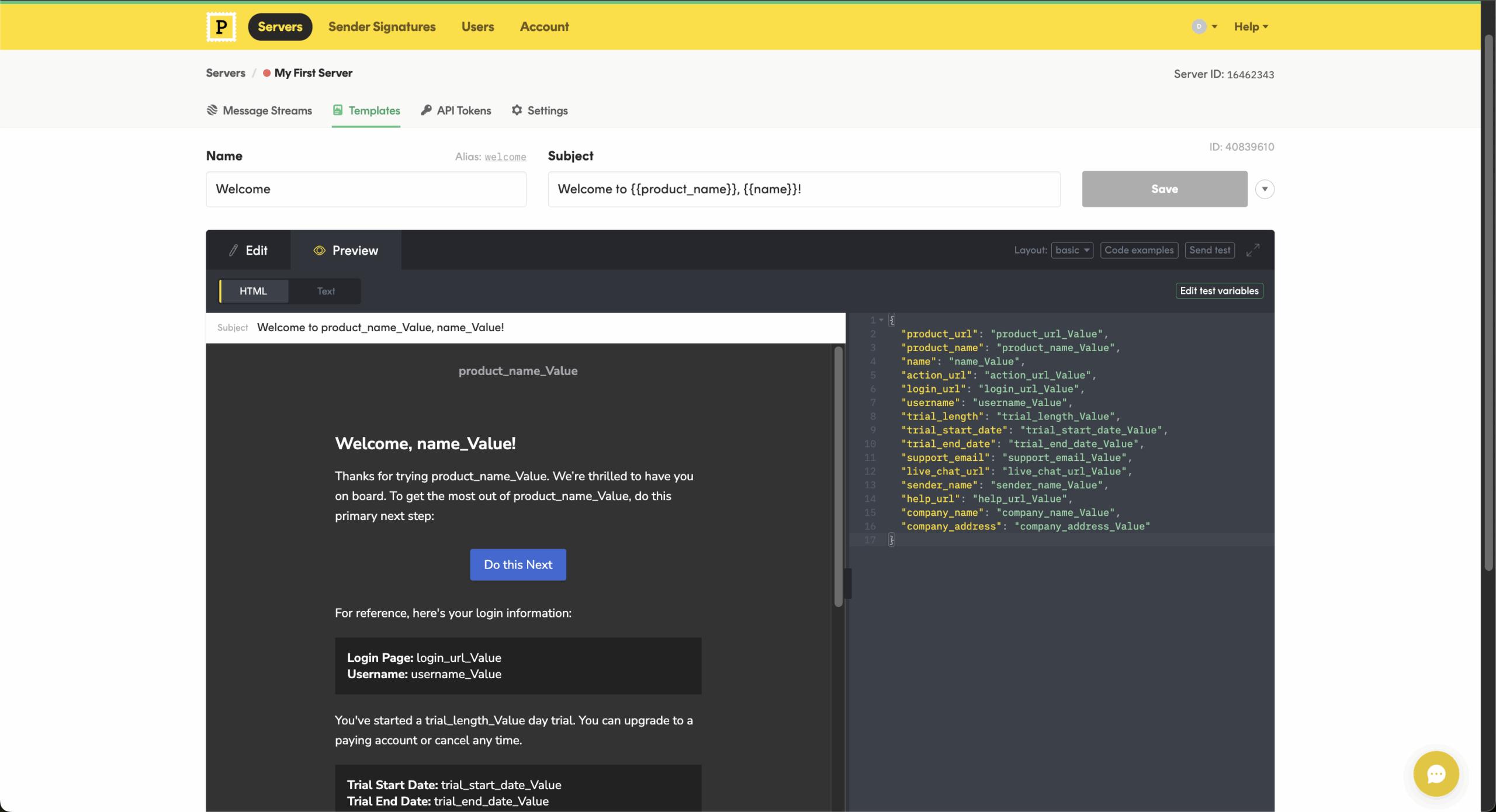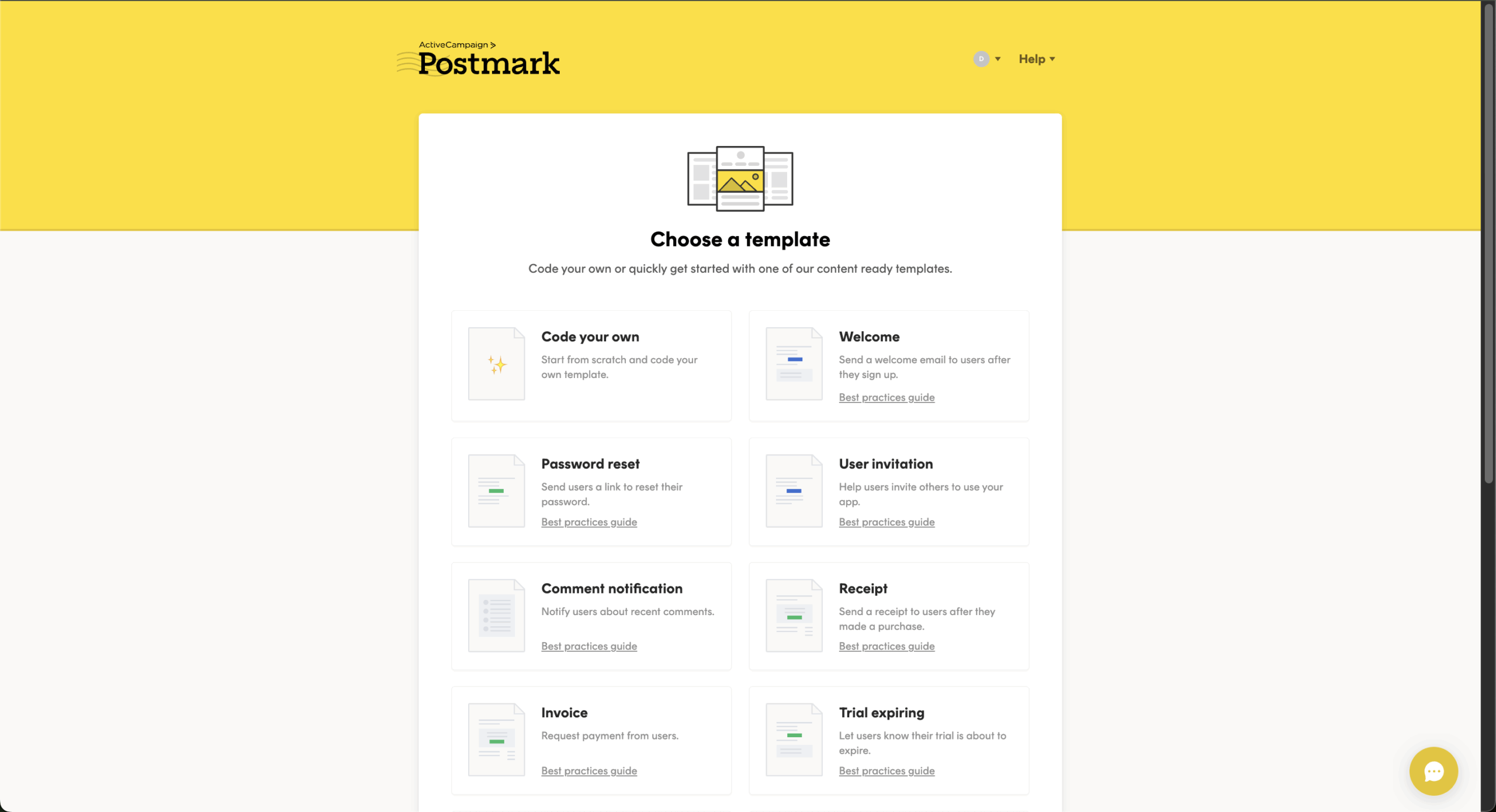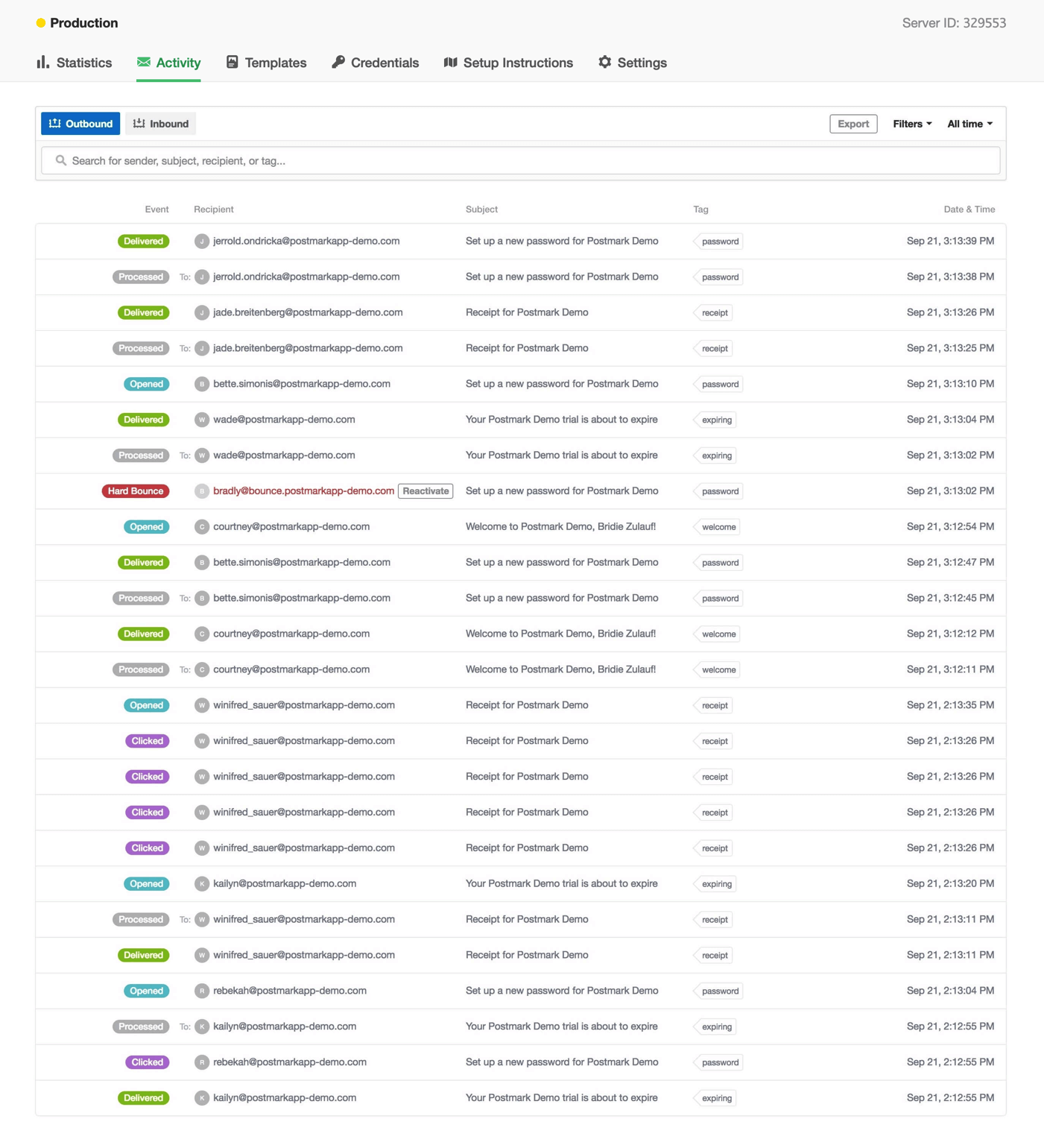- Premium features included
- No hidden costs or usage limits
- Scale from startup to enterprise


We’ve all been there. You send a password reset email and… nothing. Customer orders something, expects a confirmation, and crickets. Meanwhile, your support inbox fills up with “I never got the email” tickets. It’s maddening.
Postmark built their entire business around solving this exact problem. Since 2009, they’ve focused on one thing: making sure transactional emails actually reach people. Not marketing campaigns, not newsletters—just the emails that keep your app running.
Think of Postmark as the specialist you call when regular email just isn’t cutting it. While most email services try to do everything, Postmark does one thing really well: transactional emails.
These are the emails your app sends automatically—password resets, order confirmations, welcome messages. The kind that users expect to arrive instantly. Postmark promises delivery in under 10 seconds, and they’re confident enough to share their real-time stats publicly.
What makes them different? They keep transactional and promotional emails completely separate. Your password reset won’t get stuck behind someone’s newsletter. It’s a simple idea, but it works.
ActiveCampaign bought them in 2022, which worried some people. But Postmark still operates independently, and honestly, nothing much changed. They just have bigger backing now.
Postmark approaches campaigns differently than most platforms. Instead of blast-and-pray marketing, they focus on triggered sequences that respond to what users actually do in your app.
Message Streams are the key feature here. You can route different types of emails through different pathways. Critical stuff like password resets gets the VIP treatment, while promotional emails take a different route. It’s smart—your important emails never get mixed up with marketing campaigns.
The triggering works well for app-based businesses. Someone signs up? Welcome email. Abandons their cart? Recovery sequence. It’s not as complex as full marketing automation platforms, but it covers the basics that most apps need.

The template library covers most common scenarios—welcome emails, password resets, receipts, that sort of thing. They’re designed for function over flash, which actually makes sense for transactional emails.
Managing templates is pretty straightforward. You can edit them in the web interface or handle everything through the API. The templating system supports basic personalization and conditional content, though it’s not as sophisticated as dedicated design tools.
The templates follow deliverability best practices, which matters more than you might think. They avoid spam triggers and render consistently across email clients. Not the prettiest designs you’ll ever see, but they work reliably.

Postmark keeps automation simple, which is probably smart. They handle the technical stuff automatically—bounce processing, retry logic, suppression lists. You don’t have to think about it.
Webhooks are where things get interesting. Your app can get real-time notifications when emails bounce, get opened, or trigger other events. It’s powerful for connecting email events back to your application logic.
The platform also does reputation management behind the scenes. They monitor your sending patterns and make adjustments to maintain good deliverability. Less work for you, better results overall.
Contact management is intentionally basic. Postmark handles suppression lists automatically and categorizes bounces so you understand what went wrong. Hard bounces, soft bounces, spam complaints—they track it all.
The 45-day message history is really useful for troubleshooting. Customer says they never got an email? You can look up exactly what happened. Did it bounce? Get marked as spam? Actually get delivered but not opened?
This isn’t a CRM replacement, and it’s not trying to be. It’s focused on making sure emails get delivered and giving you the data to understand when they don’t.
Here’s where Postmark basically says “not our job.” They don’t really do landing pages or form builders. Their philosophy is pretty clear: stick to what you do best.
Integration is how they handle this gap. The API makes it easy to connect with dedicated landing page tools, CRM systems, whatever you’re already using. It’s actually refreshing—instead of building mediocre versions of everything, they just make sure their part works really well.
When you do need forms processed, Postmark excels at the follow-up emails. Contact form submission? Instant confirmation. Support request? Automatic ticket creation email. The speed and reliability are genuinely impressive.
The analytics focus on delivery performance rather than marketing metrics. You get real-time data on sent messages, delivery rates, bounce rates, opens, and clicks. It’s comprehensive without being overwhelming.
Individual message tracking is detailed. You can see the complete journey of any email—when it was sent, when it was delivered, whether it was opened. This level of visibility is invaluable when customers claim they never received something.
The reporting isn’t as marketing-focused as dedicated analytics platforms, but that’s kind of the point. It gives you what you need to optimize email delivery and troubleshoot issues.

The API is genuinely well-designed. Client libraries for pretty much every programming language, comprehensive documentation, and examples that actually work. Most developers can get emails flowing within minutes.
SMTP integration is dead simple—often just changing a few server settings. The migration process from other email services is usually painless, which is rare in this space.
Webhook support is solid, and there are enough pre-built integrations to cover common use cases. WordPress, Shopify, Help Scout, the usual suspects. Not as extensive as some platforms, but it covers what most people need.

Support quality is consistently good. The team actually understands email deliverability, which isn’t always the case with other providers. They can give you specific advice about authentication, reputation management, that kind of thing.
Documentation is excellent—comprehensive guides, working code examples, troubleshooting steps that actually help. The migration guides are particularly good if you’re switching from another service.
Response times are generally quick, though they don’t offer 24/7 support across all channels. The trade-off is that when you do get help, it’s usually from someone who knows what they’re talking about.
Postmark distinguishes itself as a transactional email service specializing exclusively in critical business communications. Their transactional email API achieves industry-leading 45-second average delivery time with 99%+ inbox placement rates, making them a premier email deliverability service.
The platform’s Message Streams feature separates transactional and broadcast emails for optimal performance, offering both API and SMTP integration.
What sets Postmark apart as a reliable transactional email provider is their transactional-only infrastructure—dedicated servers never shared with marketing traffic. The platform includes real-time activity tracking, template management with variables, automatic bounce categorization, inbound email processing, and built-in SpamAssassin spam testing.
By focusing solely on transactional vs marketing emails separation, Postmark delivers unmatched reliability for mission-critical communications.
Postmark uses straightforward volume pricing. Pay for what you send, get access to everything. No feature restrictions, no hidden fees.
Monthly Price
Emails Included
What You Get
Developer
Free
100/month
Full features, never expires
Starter
$15
10,000
Production-ready with multiple servers
Growth
$50
50,000
Same features, higher volume
Scale
$220+
500,000+
Enterprise volume pricing
The free plan is genuinely useful—100 emails monthly with full feature access that never expires. Perfect for testing, staging environments, or small projects.
Pricing scales with volume, and overage charges are automatically added to your next bill. No surprises, no gotchas. Dedicated IPs are available for high-volume senders who need extra deliverability control.
Speed is the obvious winner here. Emails typically arrive in under a second, which is genuinely impressive. When someone requests a password reset, they get it immediately. No waiting around, no frustrated users.
Deliverability rates are consistently high—usually above 99% for most accounts. This isn’t just luck; they work hard to maintain good relationships with ISPs and keep their infrastructure clean.
The developer experience is really good. Clear documentation, helpful error messages, APIs that make sense. Integration usually takes minutes rather than hours, which is rare in this space.
Marketing capabilities are pretty limited. If you need segmentation, A/B testing, or complex automation workflows, you’ll probably need another tool. Postmark can handle promotional emails, but it’s not really designed for marketing campaigns.
The pricing adds up quickly for high-volume senders. Per-email costs are higher than bulk providers like Amazon SES or SendGrid. You’re paying for premium performance, but it might not fit every budget.
The focused approach has trade-offs. No CRM features, limited analytics for marketing purposes, no landing page builders. It’s intentional, but it means juggling more tools.
Perfect For
Look Elsewhere If
Apps that depend on transactional email working reliably
Main need is marketing campaigns with automation
E-commerce sites needing fast order confirmations
Budget is tight and you’re sending high volumes
Development teams who value good APIs and docs
Want an all-in-one platform for marketing and email
Businesses where email delivery affects revenue
Sending mostly newsletters and promotional content
SaaS companies and web apps get the most value. If your business depends on emails working—user onboarding, notifications, password resets—Postmark’s reliability can save you a lot of support headaches.
Ecommerce businesses love the speed. Order confirmations and shipping notifications arrive instantly, which improves the customer experience. When someone spends money, they want immediate confirmation.
Development teams appreciate the technical approach. The API design is intuitive, documentation is comprehensive, and integration is usually straightforward. If you’ve struggled with other email services, Postmark feels refreshingly simple.
Marketing-focused businesses should probably look at Sender.net, Mailchimp, or Kit. Postmark can handle promotional emails, but it lacks the segmentation and automation features that marketing teams typically need.
High-volume bulk senders might find better value with Amazon SES or SendGrid. If you’re sending millions of promotional emails, the per-email costs can get expensive quickly.
Small businesses wanting everything in one place might prefer platforms that combine CRM, marketing, and transactional email. Postmark’s focused approach means managing multiple tools, which isn’t always practical.
G2 users consistently praise reliability and developer experience. Multiple reviews mention using Postmark for years without major issues, which says something about the platform’s stability.
The API quality gets frequent mentions. Developers appreciate the fast response times, clear error messages, and comprehensive documentation. It’s rare to see this level of satisfaction with technical implementation.
Support quality stands out in G2 reviews. Users mention getting helpful, technical responses rather than generic support ticket responses. When you’re dealing with email deliverability issues, that expertise matters.
Capterra reviewers focus on business results. Many mention specific improvements in email deliverability after switching to Postmark, with some reporting 10%+ increases in delivery rates.
Migration experiences are generally positive. Users note that switching from other email providers typically takes less time than expected, with good documentation and support during the transition.
Value opinions vary depending on use case. Businesses relying heavily on transactional email tend to see the cost as justified, while those with mixed needs sometimes find it expensive.
Trustpilot shows more mixed experiences, particularly around account management. Some users praise the technical performance while expressing frustration with account approval processes.
Long-term users tend to be very satisfied. Multiple reviews from 3+ year customers mention that Postmark “just works” without requiring constant attention or troubleshooting.
Customer service experiences vary more on Trustpilot than other platforms. The technical performance generally gets high marks, but business relationship aspects are less consistent.
Sender takes a completely different approach—affordable email marketing with generous free plans (up to 15,000 monthly emails). Where Postmark specializes in premium transactional delivery, Sender focuses on marketing automation at budget-friendly prices.
Feature sets barely overlap. Sender includes segmentation, marketing workflows, landing pages, and campaign analytics. Postmark focuses on transactional email speed and reliability. They’re solving different problems.
For businesses needing both, the choice depends on priorities. Sender offers better value for marketing operations, while Postmark excels when transactional email reliability directly affects your business. Some companies use both—Postmark for critical emails, Sender for marketing campaigns.
SendGrid offers broader functionality in a single platform—both transactional and marketing capabilities with more comprehensive analytics and template options. It’s more of an all-in-one solution.
Pricing favors SendGrid for mixed usage, especially at higher volumes. When comparing Postmark vs Sendgrid, SendGrid provides better volume discounts and can handle both promotional and transactional emails cost-effectively.
Performance comparisons consistently favor Postmark for speed and deliverability. SendGrid’s broader feature set comes with more complexity, while Postmark’s focus often results in better reliability for transactional use cases.
Postmark vs Mailtrap serves two completely different needs in the email workflow. Postmark is a production email service specializing in transactional emails with lightning-fast delivery and industry-leading inbox placement rates. It provides detailed analytics, webhook support, and rock-solid reliability for customer-facing emails.
Mailtrap is an email testing tool designed for development and staging environments. It catches all your test emails so you can inspect them without risking sends to real users.
Use Postmark when you need to actually deliver emails to customers. Use Mailtrap when you’re building and testing email functionality before going live.
Postmark does exactly what it promises—fast, reliable transactional email that consistently reaches inboxes. If your business depends on email functionality working properly, the performance improvements are usually worth the premium pricing.
The platform shines when email reliability directly impacts your business. Password resets that arrive instantly, order confirmations that never disappear into spam folders, welcome emails that actually welcome people. These seemingly small improvements can significantly affect user experience.
But Postmark isn’t right for everyone. Businesses focused primarily on marketing campaigns will find better value with dedicated marketing platforms. The focused approach means accepting some limitations in exchange for exceptional transactional email performance.
Consider Postmark when your app or business genuinely depends on transactional emails working reliably, you value excellent developer tools and documentation, and the premium pricing fits your budget. Look elsewhere if marketing automation is your main need, you’re primarily sending promotional content, or cost optimization is more important than performance optimization.
For transactional email, Postmark simply works better than most alternatives. Whether that’s worth the extra cost depends on how much email reliability matters to your specific business.
